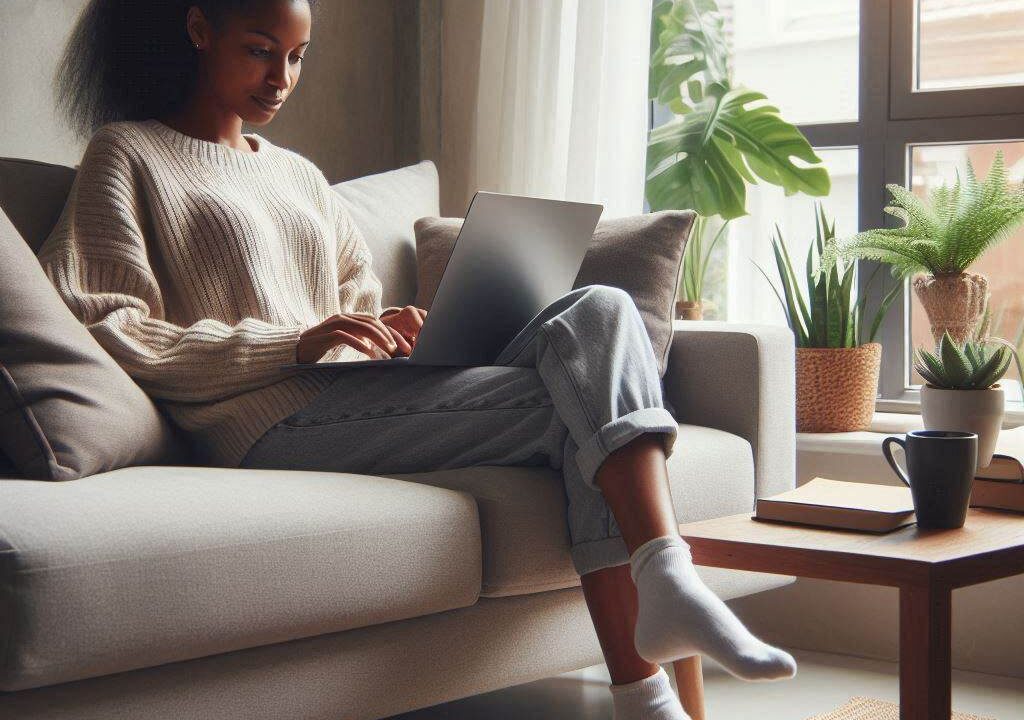The way we work has shifted dramatically, and working from home has become a common reality for millions of people around the world. One of the key tools that makes remote work possible is the laptop. But many people wonder, can you really use a laptop to work from home effectively? The short answer is yes, but the details depend on several factors, including the type of work you do, the laptop you have, and your home setup. Let’s explore this topic in depth.
1. Laptops: A Perfect Tool for Remote Work
Laptops have become the go-to device for work, both in offices and at home. Their portability, combined with sufficient computing power, allows them to handle a wide range of tasks, from simple word processing to more complex activities like video editing or software development. The flexibility of a laptop means you can move from room to room in your home or even take your work with you to a café or co-working space.
Why are laptops ideal for remote work?
- Portability: You can easily move around, work from different locations, and switch between your desk, couch, or kitchen table.
- Built-in features: Most laptops come with built-in cameras, microphones, and speakers, which are essential for virtual meetings, making communication with your team easy.
- Wi-Fi connectivity: Laptops are designed to connect seamlessly to wireless networks, allowing for flexible and untethered internet use, which is key for remote work.
2. Types of Work You Can Do From Home With a Laptop
The type of work you can do from home on a laptop largely depends on the nature of your job and the specifications of your laptop. Here are some common remote work tasks that a laptop can handle:
- Office work: Writing emails, creating reports, managing spreadsheets, and preparing presentations can all be done easily on a standard laptop.
- Virtual meetings: Tools like Zoom, Microsoft Teams, and Google Meet allow you to attend or host meetings from anywhere, as long as you have a stable internet connection and a webcam.
- Creative work: Graphic designers, writers, and marketers can use design software (like Adobe Creative Cloud), word processors, or social media management tools on laptops.
- Programming and IT work: Laptops are used by many software developers, web designers, and IT professionals for coding, troubleshooting, and deploying applications.
- Customer service: Many customer service representatives work from home, using laptops to respond to customer inquiries, troubleshoot issues, and handle client accounts through cloud-based software.
For more information, you can speak to Happy Face
3. Laptop Specifications for Working From Home
While most laptops are equipped to handle basic work tasks, some jobs require more power, memory, or specialized features. Here’s a breakdown of the key specifications to consider when using a laptop for remote work:
- Processor (CPU): The processor is the brain of the laptop, and the faster it is, the better it can handle multitasking. For general office work, an Intel Core i5 or equivalent is usually sufficient. However, for more demanding tasks like video editing or 3D modeling, a more powerful processor like an Intel Core i7 or i9 (or equivalent AMD Ryzen processors) may be necessary.
- RAM (Memory): RAM determines how much data your laptop can handle at once. For basic tasks like browsing and word processing, 8 GB of RAM is sufficient. However, for more intensive applications like graphic design or software development, you may need 16 GB or more.
- Storage: Laptops typically come with either HDD (hard disk drives) or SSD (solid-state drives). SSDs are much faster, so they’re preferred for faster boot times and quick file access. For most remote work tasks, 256 GB of SSD storage is enough, but if you deal with large files (like videos or high-res images), you might need 512 GB or more.
- Display: A high-resolution screen (Full HD or higher) is crucial if you’ll be spending a lot of time in front of the screen. If your job involves graphic design or video editing, you might even want a laptop with a 4K display for better detail.
- Battery life: A laptop with long battery life (8-12 hours or more) allows you to work for extended periods without needing to plug in, giving you more freedom to move around your home or work remotely from other locations.
- Webcam and Microphone: Virtual meetings are an essential part of remote work, so a built-in webcam and microphone are important. Many laptops today come with high-definition webcams and decent microphones, but external webcams and mics can be purchased for better quality if necessary.
For more information, you can speak to Happy Face
4. Setting Up Your Home Workspace
While using a laptop for remote work is possible, you still need a comfortable and productive workspace. Simply working from your couch or bed might not be ideal in the long term, as it can affect both your posture and productivity. Here are some tips to create an effective home office:
- Ergonomics: To prevent strain, it’s a good idea to invest in a proper chair and desk that supports good posture. You can also elevate your laptop with a stand so that the screen is at eye level, which reduces neck strain.
- External peripherals: Using a separate mouse, keyboard, and monitor can make working on a laptop more comfortable, especially for extended periods. An external monitor can provide additional screen space, improving productivity for tasks that require multiple windows.
- Stable internet connection: Working from home requires a reliable internet connection, especially if your job involves video conferencing or large file transfers. Consider upgrading to a high-speed internet plan and placing your router in a central location for optimal Wi-Fi coverage.
- Noise management: If you have a noisy household, noise-cancelling headphones can help you concentrate during work hours, especially during meetings.
For more information, you can speak to Happy Face
5. Managing Distractions and Staying Productive
Working from home offers flexibility, but it also comes with the challenge of managing distractions. Unlike a traditional office setting, home environments can have interruptions from family members, household chores, or other distractions.
Here are some strategies to stay focused while working on a laptop from home:
- Set a schedule: Establish a regular work routine, including start and end times, to create structure in your day.
- Designate a workspace: Set up a specific area in your home for work. This helps you mentally separate work time from leisure time, even when you’re working from a laptop.
- Minimize distractions: Let others in your household know when you’re working to minimize interruptions. Consider using apps or browser extensions that block distracting websites or social media during work hours.
- Take breaks: Use the Pomodoro technique (25 minutes of focused work followed by a 5-minute break) to maintain productivity and prevent burnout. Step away from your laptop during breaks to recharge your mind and body.
6. Remote Work Tools for Laptops
Laptops offer a vast range of software tools that make working from home efficient. Some popular tools include:
- Communication tools: Slack, Microsoft Teams, and Zoom for virtual meetings and real-time communication with coworkers.
- Project management tools: Asana, Trello, or Monday.com to keep track of tasks, deadlines, and collaborate with teams.
- Cloud storage: Google Drive, Dropbox, and Microsoft OneDrive allow you to store and share files securely, ensuring that you can access important documents no matter where you are.
For more information, you can speak to Happy Face
Yes, you can absolutely use a laptop to work from home, and for many people, it is the most convenient and efficient option. Laptops provide portability, flexibility, and all the tools needed to maintain productivity in a remote work environment. However, to work effectively from home, you need to ensure that your laptop meets the requirements of your job, your workspace is conducive to focus, and that you have a reliable internet connection. With the right setup and habits, working from home on a laptop can be just as productive (if not more so) as working in a traditional office.
Disclaimer
Related Post :
Do employers give you a laptop?
Can you use your work laptop for personal use?
What happens if you break your work laptop?








